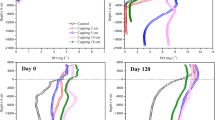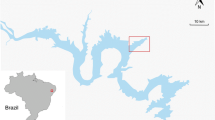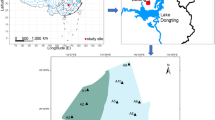Abstract
The purpose of current study was to investigate the effects of sediment desiccation on nutrient dynamics and eutrophication in wetlands during the presence or absence of wiry and sturdy rooted emergent macrophytes, based on the hypothesis that sediment desiccation negatively correlated with plants nutrient uptake abilities and positively with nutrients fluxes at sediment-water interface. Growth of four emergent macrophytes, including two wiry rooted plants, i.e., Alocasia cucullata and Aglaonema commutatum, and two sturdy rooted plants, i.e., Cannabis indica and Acorus calamus, were grown and investigated in dried-rewetted sediments (DS) and constantly wet sediments (WS), respectively, for 6 months. The findings revealed that sediment drying and rewetting process significantly decreased the diffusion of overlying nutrient into sediment and the particle size density, porosity, and nutrients’ repository ability in DS treatments, while the sediment bulk density and mineralization of organic macronutrients increased. Compared to WS treatments, the DS treatments impaired plant growth, root biomass, shoot biomass, and stimulated higher fluxes of ammonium nitrogen (\( {\mathbf{NH}}_{\mathbf{4}}^{+} \)–N, 0.042−0.081 mg m – 2 d – 1) and phosphate (P\( {\mathbf{O}}_{\mathbf{4}}^{\mathbf{3}\hbox{--}}\hbox{--} \mathbf{P}, \) 0.009−0.030 mg m–2 d–1) at sediment-water interface upon rewetting. The higher internal release of macronutrients and dissolved organic carbon (DOC) from DS led to the higher chlorophyll-a (Chl-a) concentrations (34.47−21.28 to 41.76−33.36 μg L–1) in their water column than in the water column of WS. The wiry rooted plants with higher root biomass displayed lower internal release of \( {\mathbf{NH}}_{\mathbf{4}}^{+} \)–N, PO43–P and DOC and water column Chl-a concentrations than the sturdy rooted plants in two sediment types. Root biomass of plants correlated positively with TN (63−87%) and TP (56−78%) removal percentages from WS and DS. These results demonstrated that sediment desiccation process reduced plant growth and enhanced internal loading of nutrients and consequently accelerated eutrophication in these wetlands.








Similar content being viewed by others
Data Availability
Data used in this article is available either in manuscript or supplementary information.
References
Ali F, Jilani G, Fahim R, Bai L, Wang C, Tian L, Jiang H (2019) Functional and structural roles of wiry and sturdy rooted emerged macrophytes root functional traits in the abatement of nutrients and metals. Journal of Environmental Management 249:109330
Andersen JM (1976) An ignition method for determination of total phosphorus in lake sediments. Water Resarch 10:329–331
Apple JK, Smith EM, Boyd TJ (2008) Temperature, salinity, nutrients, and the covariation of bacterial production and chlorophyll-a in estuarine ecosystems. Journal of Coastal Research 10055:59–75
Bai X, Chen K, Ren K, Huang W, Chen X (2012) Impacts of four emergent macrophytes on sediment nutrient loading. Journal of Freshwater Ecology 27:481–493
Baldwin DS, Mitchell A (2000) The effects of drying and re-flooding on the sediment and soil nutrient dynamics of lowland river–floodplain systems: a synthesis regulated rivers: research & management. An International Journal Devoted to River Research and Management 16:457–467
Barko JW, Smart RM (1986) Sediment-related mechanisms of growth limitation in submersed macrophytes. Ecology 67:1328–1340
Blossfeld S, Gansert D, Thiele B, Kuhn AJ, Lösch R (2011) The dynamics of oxygen concentration, pH value, and organic acids in the rhizosphere of Juncus spp. Soil Biology Biochemistry 43:1186–1197
Bodelier PLE, Duyts H, Blom CWPM, Laanbroek HJ (1998) Interactions between nitrifying and denitrifying bacteria in gnotobiotic microcosms planted with the emergent macrophyte Glyceria maxima FEMS Microbiology. Ecology 25:63–78
Borgesa AV, Gypensb N (2010) Carbonate chemistry in the coastal zone responds more strongly to eutrophication than ocean acidification. Limnology and Oceanography 55:346–353
Bornette G, Puijalon S (2011) Response of aquatic plants to abiotic factors: a review. Aquatic Sciences 73:1–14
Carmignani JR, Roy AH (2017) Ecological impacts of winter water level drawdowns on lake littoral zones: a review. Aquatic Sciences 79:803–824
Cavanaugh JC, Richardson WB, Strauss EA, Bartsch LA (2006) Nitrogen dynamics in sediment during water level manipulation on the Upper Mississippi River. River Research and Applications 22:651–666
Chen ZH, Chen F, Cheng XY, Liu XC, Zhou XY (2004) Researches on macrophyte roots in the constructed wetlands (a review). Plant Biolology 5:131–142
Chen W, Chen Z, He Q, Wang X, Wang C, Chen D, Lai Z (2007) Root growth of wetland plants with different root types. Acta Entomologica Sinica 27:450–457
Cheng X-Y, Chen WY, Gu BH, Liu XC, Chen F, Chen ZH, Zhou XY, Li YX, Huang H, Chen YJ (2009) Morphology, ecology, and contaminant removal efficiency of eight wetland plants with differing root systems. Hydrobiologia 623:77–85
Clavero V, Izquierdo JJ, Fernández JA, Niell FX (2000) Seasonal fluxes of phosphate and ammonium across the sediment-water interface in a shallow small estuary (Palmones River, southern Spain). Marine Ecology-progress Series 198:51–60
Cooke GD (1980) Lake level drawdown as a macrophyte control technique. Journal of the American Water Resources Association 16:317–322
Corstanje R, Reddy KR (2004) Response of biogeochemical indicators to a drawdown and subsequent reflood. Journal of Environmental Quality 33:2357–2366
Dai A (2011) Drought under global warming: a review Wiley interdisciplinary reviews. Climate Change 2:45–65
Daneshgar S, Callegari A, Capodaglio A, Vaccari D (2018) The potential phosphorus crisis: resource conservation and possible escape technologies: a review. Resources 7:37
de Vicente I, Andersen FØ, Hansen HCB, Cruz-Pizarro L, Jensen HS (2010) Water level fluctuations may decrease phosphate adsorption capacity of the sediment in oligotrophic high mountain lakes. Hydrobiologia 651:253–264
De Vittor C, Relitti F, Kralj M, Covelli S, Emili A (2016) Oxygen, carbon, and nutrient exchanges at the sediment–water interface in the Mar Piccolo of Taranto (Ionian Sea, southern Italy). Environmental Science and Pollution Research 23:12566–12581
Engels C, Marschner H (1995) In: Bacon P (ed) Nitrogen fertilization in the environment. Marcel Dekker Inc., New York, pp 41–81
Furey P, Nordin R, Mazumder A (2004) Water level drawdown affects physical and biogeochemical properties of littoral sediments of a reservoir and a natural lake. Lake and Reservoir Management 20:280–295
Gu X, Zhang L, Bo X, Fan C (2010) Characteristics of sediments and pore water in Lake Nansi wetland. Environmental Science 31:939–945
Hellsten S, Riihimäki J (1996) Effects of lake water level regulation on the dynamics of littoral vegetation in northern Finland. Hydrobiologia 340:85–92
Hickey CW, Gibbs MM (2009) Lake sediment phosphorus release management—decision support and risk assessment framework. New Zealand Journal of Marine and Freshwater Research 43:819–856
Jensen HS, Andersen FO (1992) Importance of temperature, nitrate, and pH for phosphate release from aerobic sediments of four shallow, eutrophic lakes. Limnology and Oceanography 37:577–589
Keitel J, Zak D, Hupfer M (2016) Water level fluctuations in a tropical reservoir: the impact of sediment drying, aquatic macrophyte dieback, and oxygen availability on phosphorus mobilization. Environmental Science and Pollution Research 23:6883–6894
Kumar S, Dutta V (2019) Constructed wetland microcosms as sustainable technology for domestic wastewater treatment: an overview. Environmental Science and Pollution Research 26:11662–11673
Kyambadde J, Kansiime F, Gumaelius L, Dalhammar G (2004) A comparative study of Cyperus papyrus and Miscanthidium violaceum-based constructed wetlands for wastewater treatment in a tropical climate. Water Research 38:475–485
Lai WL, Wang SQ, Peng CL, Chen ZH (2011) Root features related to plant growth and nutrient removal of 35 wetland plants. Water Research 45:3941–3950
Lai W-L, Zhang Y, Chen Z-H (2012) Radial oxygen loss, photosynthesis, and nutrient removal of 35 wetland plants. Ecological Engineering 39:24–30
Leira M, Cantonati M (2008). Effects of water-level fluctuations on lakes: an annotated bibliography. In: Ecological effects of water-level fluctuations in lakes. Springer, pp 171-184
Li X, Nan R (2017) A bibliometric analysis of eutrophication literatures: an expanding and shifting focus. Environmental Science and Pollution Research 24:17103–17115
Li Q, Xiao J, Ou T, Han M, Wang J, Chen J, Li Y, Salmaso N (2018) Impact of water level fluctuations on the development of phytoplankton in a large subtropical reservoir: implications for the management of cyanobacteria. Environmental Science and Pollution Research 25:1306–1318
Lu J, Bunn SE, Burford MA (2017) Effects of water level fluctuations on nitrogen dynamics in littoral macrophytes. Limnology and Oceanography 63:833–845
Lu J, Bunn SE, Burford MA (2018) Nutrient release and uptake by littoral macrophytes during water level fluctuations. Science of The Total Environment 622-623:29–40
McCann KS, Rasmussen JB, Umbanhowar J (2005) The dynamics of spatially coupled food webs. Ecology Letters 8:513–523
Mei XQ, Wong MH, Yang Y, Dong HY, Qiu RL, Ye ZH (2012) The effects of radial oxygen loss on arsenic tolerance and uptake in rice and on its rhizosphere. Environmental Pollution 165:109–117
Mei X-Q, Yang Y, Tam NF-Y, Wang Y-W, Li L (2014) Roles of root porosity, radial oxygen loss, Fe plaque formation on nutrient removal and tolerance of wetland plants to domestic wastewater. Water Research 50:147–159
Meng X, Zhang W, Shan B (2020) Distribution of nitrogen and phosphorus and estimation of nutrient fluxes in the water and sediments of Liangzi Lake, China. Environmental Science and Pollution Research 27:7096–7104
Peng C, Zhang Y, Huang S, Li X, Wang Z, Li D (2019) Sediment phosphorus release in response to flood event across different land covers in a restored wetland. Environmental Science and Pollution Research 26:9113–9122
Qui S, McComb A (1996) Drying-induced stimulation of ammonium release and nitrification in reflooded lake sediment. Marine and Freshwater Research 47:531–536
Rejmánková E (2011) The role of macrophytes in wetland ecosystems. Journal of Environment and Ecology 34:333–345
Ruban V, López-Sánchez J, Pardo P, Rauret G, Muntau H, Quevauviller P (1999) Selection and evaluation of sequential extraction procedures for the determination of phosphorus forms in lake sediment. Journal of Environmental Monitoring 1:51–56
Siver PA, Coleman AM, Benson GA, Simpson JT (1986) The effects of winter drawdown on macrophytes in Candlewood lake, Connecticut. Lake and Reservoir Management 2:69–73
Song J (1997) Chemistry of sediment–seawater interface of the China seas. China Ocean Press, Beijing, pp 6–8
Song K-Y, Zoh K-D, Kang H (2007) Release of phosphate in a wetland by changes in hydrological regime. Science of The Total Environment 380:13–18
Steinman A, Chu X, Ogdahl M (2009) Spatial and temporal variability of internal and external phosphorus loads in Mona Lake, Michigan. Aquatic Ecology 43:1–18
Steinman AD, Ogdahl ME, Weinert M, Thompson K, Cooper MJ, Uzarski DG (2012) Water level fluctuation and sediment–water nutrient exchange in Great Lakes coastal wetlands. Journal of Great Lakes Resarch 38:766–775
Sutela T, Aroviita J, Keto A (2013) Assessing ecological status of regulated lakes with littoral macrophyte, macroinvertebrate and fish assemblages. Ecological indicators 24:185–192
Van Heukelem L, Lewitus AJ, Kana TM, Craft NE (1994) Improved separations of phytoplankton pigments using temperature-controlled high performance liquid chromatography. Marine Ecology Progress Series 114:303–313
Wilson JS, Baldwin DS (2008) Exploring the ‘Birch effect’ in reservoir sediments: influence of inundation history on aerobic nutrient release. Journal of Chemical Ecology 24:379–386
Yu J, Zhang J, Chen Q, Yu W, Hu L, Shi W, Zhong J, Yan W (2018) Dramatic source-sink transition of N2O in the water level fluctuation zone of the Three Gorges Reservoir during flooding-drying processes. Environmental Science and Pollution Research 25:20023–20031
Yu H, Xu S, Tian W, Zhu L, Sun Y (2019a) Impact of long-term water level fluctuation on the distribution, transport, and fate of phosphorus in reservoir sediment. Environmental Science and Pollution Research 26:33146–33156
Yu J, Zhang Y, Zhong J, Ding H, Zheng X, Wang Z, Zhang Y (2019b). Water-level alterations modified nitrogen cycling across sediment-water interface in the Three Gorges Reservoir. Environmental Science and Pollution Research, 1-13
Zhang H, Zhao Y, Yin H, Wang Y, Li H, Wang Z, Geng Y, Liang W, Wang H (2019) Effect of aquatic macrophyte growth on landscape water quality improvement. Environmental Science and Pollution Research 26:33791–33803
Zhang Y, Li C, Ji X, Yun C, Wang M, Luo X (2020) The knowledge domain and emerging trends in phytoremediation: a scientometric analysis with CiteSpace. Environmental Science and Pollution Research 27:15515–15536
Zohary T, Ostrovsky I (2011) Ecological impacts of excessive water level fluctuations in stratified freshwater lakes. Inland Waters 1:47–59
Funding
This work was supported by grants from the National Natural Science Foundation of China (51839011 and 51861125201) and the Natural Science Foundation of Jiangsu Province (BK20191098).
Author information
Authors and Affiliations
Contributions
F.A.: conceptualization, methodology, investigation, validation, data curation, formal analysis, visualization, writing original draft. L.B.: conceptualization, investigation, formal analysis, writing original draft. Z.H.: methodology, validation, writing review and editing. C.W.: conceptualization, methodology, investigation, validation, data curation, formal analysis. L.T.: investigation, validation, data curation, formal analysis. H.J.: funding acquisition, conceptualization, investigation, writing review and editing. All authors read and approved the final manuscript.
Corresponding authors
Ethics declarations
Ethics approval
Not applicable,
Consent to participate
Not applicable.
Consent for publication
Not applicable.
Competing interests
The authors declare no competing interests.
Additional information
Responsible Editor: Philippe Garrigues
Publisher’s note
Springer Nature remains neutral with regard to jurisdictional claims in published maps and institutional affiliations.
Supplementary information
ESM 1
(DOCX 726 kb)
Rights and permissions
About this article
Cite this article
Ali, F., Bai, L., Hao, Z. et al. The contribution of sediment desiccation and rewetting process to eutrophication in the presence and absence of emergent macrophytes. Environ Sci Pollut Res 29, 7254–7270 (2022). https://doi.org/10.1007/s11356-021-16131-3
Received:
Accepted:
Published:
Issue Date:
DOI: https://doi.org/10.1007/s11356-021-16131-3




